The Curse of Oak Island: Season 6, Episode 2- Gold Rush
The following is a plot summary and analysis of Season 6, Episode 2 of the History Channel’s TV series The Curse of Oak Island.
[SPOILER ALERT!]
Plot Summary
Rick Lagina and Gary Drayton pay a visit to Dan Blankenship’s home on Oak Island. In Blankenship’s kitchen, they find the veteran treasure hunter in conversation with Marty Lagina. Rick and Gary interrupt their companions to show them the bejeweled brooch discovered at the end of the previous episode on Oak Island’s Lot 21. As Dan and Marty examine the artifact, the narrator reminds us that Drayton found a similar piece of jewelry on Lot 8 the previous season. Following the narrator’s exposition, Rick observes, in an interview, that “the jewel is much smaller than the find last year, [has] a little more intricate design on the setting, [and] is much more well-preserved.” Back in Dan’s kitchen, Gary Drayton says, “I have visions of… pirates filling their pockets with jewelry, running across the island, dropping this stuff.”
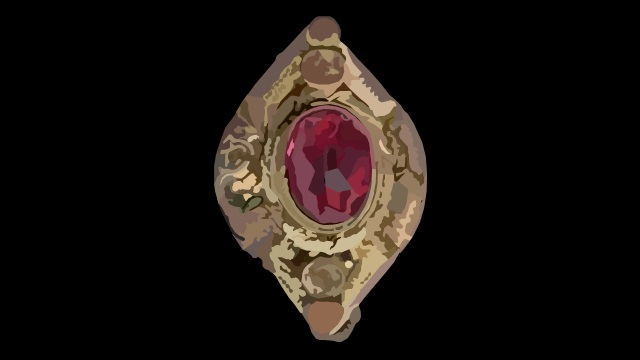
After the narrator briefly touches on theories which the brooch evokes, including the pirate theory, the story of Captain James Anderson, and the hypothesis revolving around Marie Antoinette’s jewels, the four treasure hunters all agree that the ought to have an expert determine the artifact’s age.
While Charles Barkhouse watches as the men of Eagle Canada wrap up their seismic survey in the Money Pit area, Laird Niven meets Rick and Marty Lagina and Gary Drayton at the Oak Island Visitors’ Centre. Drayton informs the archaeologist that Lots 21 and 22 have been cleared of trees and brush, allowing him to metal detect there more efficiently and effectively. He then shows Niven the brooch that he dug up on Lot 21. Niven examines the artifact for some time before declaring that he has never seen anything like it before. He also observes that the brooch’s ornamental housing has been gilded, or coated with gold leaf, and encourages the team to have it analyzed by an expert in antique jewelry.
The next day, Rick Lagina and Gary Drayton meet with representatives of Brycon Construction and Irving Equipment Ltd., the contractors tasked with building an enormous cofferdam around Smith’s Cove. While the men shake hands, the narrator informs us that this structure will be 25 feet deep and composed of metal.
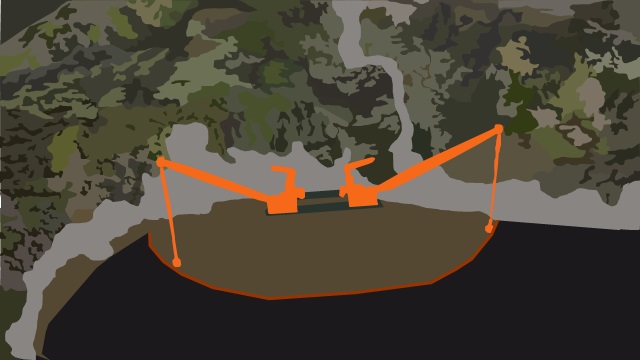
Rick explains in an interview that in order to begin work at Smith’s Cove, they will first have to build a substantial road from Borehole 10-X to the beach. This road will need to support the 300 ton crane with which the cofferdam will be constructed.
Later, the Oak Island team meets at the Mug & Anchor Pub in the nearby town of Mahone Bay. Rick Lagina informs the crew that they have arranged for a gemologist in Calgary, Alberta, to take a look at the two brooches found on Oak Island.
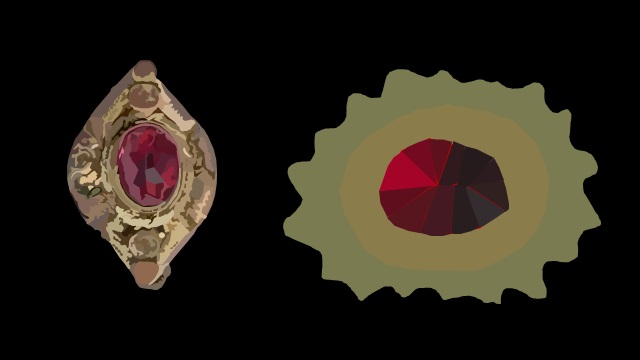
We are then transported to Calgary, Alberta, where the Lagina brothers and Dave Blankenship are driving. The treasure hunters head to the Alberta College of Art and Design, where they meet with gemologist and master goldsmith Charles Lewton-Brain and his assistant Axel Bernal Bladh. Lewton-Brain, who has agreed to take a look at the two brooches, removes the rhodolite garnet from its housing and examines it using a digital video microscope. He remarks that “the facets… don’t meet perfectly”, which he claims is an indication that they were hand-cut (as opposed to machine-cut). He later declares that the garnet has a refractive index of over 1.7; for reference, he states that a ruby’s refractive index is 1.74. After examining the gem under another microscope, he declares that the stone indeed appears to be a garnet.
Next, Lewton-Brain examines the stone ensconced in the Lot 21 brooch. He quickly discovers tiny bubbles inside the object when examining it under a microscope, which leads him to conclude that the material is actually coloured glass. After the Lagina brothers express their disappointment with this development, Charles Lewton-Brain informs them that the bauble is definitely “handmade” and “not modern”. “Glass gems have been around at least 500 years,” the gemologist continues. “Leaded glass has been used a long time because the light passes through it well…”
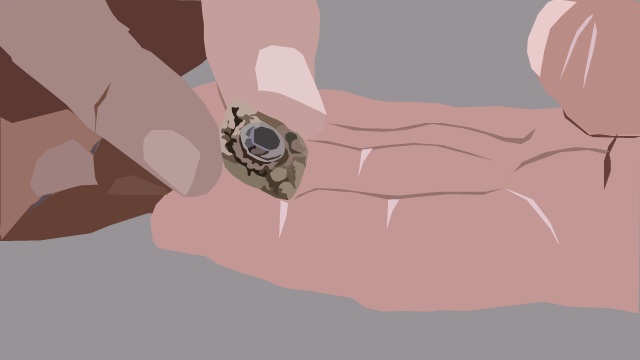
Marty asks the gemologists what accounts for the bauble’s red colour. Axel Bladh then informs him that “the formulas for making red glass have been lost and found and lost and found again several times through history… Glass people were extremely secretive. Each family that was working glass would have their own little book of recipes, sometimes in code.” This revelation prompts the narrator to remind us of the Rosicrucian theory, which holds that members of a secret 17th Century society are behind the Oak Island mystery.
After that, Lewton-Brain examines the settings in which the gems were housed. While examining the Lot 21 brooch, he draws the treasure hunters’ attention towards a metal cord which encircles the bezel. “If you look at this cord, or wire,” he explains, “you can see that there’s a spiral nature to it… This is not your ordinary old brooch found in the ground. That is a super ancient way of making wire.” He later explains that the method by which this wire was formed is called “block twisting”.
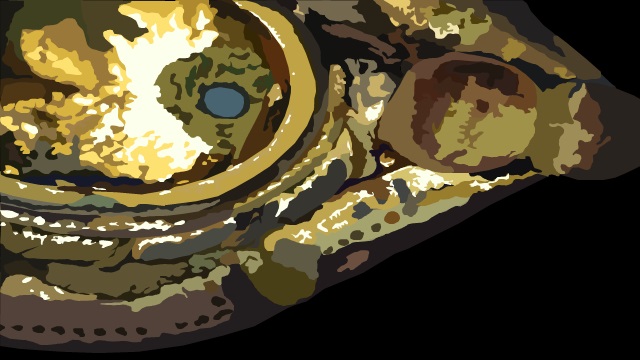
When Marty asks the gemologist how old he believes the artifact to be, Lewton-Brain explains that block twisting fell out of fashion after 1340 A.D., when it was eclipsed by wire drawing with draw plates. “Potentially older than 1340?” asks an incredulous Marty Lagina. “Yeah,” replies Lewton-Brain, nodding his head.
In response to this assessment, Marty says, “I’ve been completely unwilling to believe that what happened on Oak Island happened pre-1400s… And now you’ve got this.” In a later interview, Marty explains that, although some uncertainty still remains, Lewton-Brain’s analysis of the Lot 21 brooch has opened his mind up to new possibilities.
Lewton-Brain concludes his analysis by stating that the Lot 21 brooch is possibly “countryside work” and definitely of European origin. He encourages the Oak Island crew to consult the databases of London, England’s British Gemological Society, from which they might be able to learn more about their artifacts.
The following day, Marty Lagina, Craig Tester, and Alex Lagina drive to St. Mary’s University in Halifax, Nova Scotia. There, they meet with associate professor of Chemistry Dr. Christa Brosseau and research instrument technician Dr. Xiang Yang. The treasure hunters present the scientists with the Lot 21 brooch, which Brosseau and Yang subsequently examine with an electron microscope. The scientists determine that the outer decorative housing is made of brass, and that the inner housing in which the glass gem is set is composed of pure copper. They also conclude that, in accordance with Laird Niven’s assertion, parts of the brooch are coated in gold leaf.
Later that afternoon, the Oak Island crew meets in the War Room. There, Marty relates the recent revelations regarding the Lot 21 brooch. “David,” he says, turning to Dave Blankenship- who has formerly declared that his chief interest in Oak Island lies in the acquisition of its elusive “spendables”- “this little gem has gold on it. We have found our first gold on Oak Island.”
“I want more gold than that,” says a clearly unimpressed Dave, to which Marty replies, “Well, come on, man. Small victories, right?”
Later, Rick Lagina and Dan Henskee walk to the Money Pit area, where the men of Eagle Canada inform them that their seismic survey is complete. The seismic crew members tell the treasure hunters that the survey data should be fully analyzed in “a couple weeks”.
The episode ends with the narrator’s announcement that the road to Smith’s Cove has been completed, and that the construction of the cofferdam will soon commence. The camera pans to the causeway, where tractor-trailers loaded with heavy equipment slowly make their way onto the island.
Analysis
The Glass Gem
In this episode, Calgary-based gemologist Charles Lewton-Brian examines the gem from the brooch found on Oak Island’s Lot 21 and determines that it is made of red-coloured lead glass. He immediately remarks that the artifact could be up to 500 years old.

Coloured glass has been used in jewelry for millennia, often functioning as imitation gemstones. Considering its colour, the glass gem in the Lot 21 brooch was perhaps meant to imitate a ruby. The fact that the gem bears facets, considering the history of facet-cutting, suggests that it was probably crafted no earlier than the 1400s.
Block Twisting
In this episode, Charles Lewton-Brain examines the brooch found on Oak Island’s Lot 21 and observes that the wire that encircles the artifact’s bezel bears diagonal lines. These markings, according to Lewton-Brain, indicate that the wire was formed through block twisting- an ancient method of wire manufacture not commonly found in post-14th Century artifacts.

Block twisting was employed as early as Classical Antiquity. This wire-making method involves hammering a quantity of metal into a thin sheet, cutting a narrow ribbon from this sheet, and twisting the ribbon at both ends as tightly as possible. The twisted cord is then rolled between two planks of hard wood until it forms a smooth wire. Although the spiral-shaped grooves resultant of the twisting process can be completely removed during the rolling process, some vestige of these markings usually remains.
Block twisting was not the only method used by ancient wire makers. Another method, called “strip-drawing”, involves threading thin metal strips through small holes. While passing through the hole, the strip curls in on itself, forming a thin, hollow tube. A simpler, more primitive method of wire making involves hammering and rolling an ingot until it forms a cord.
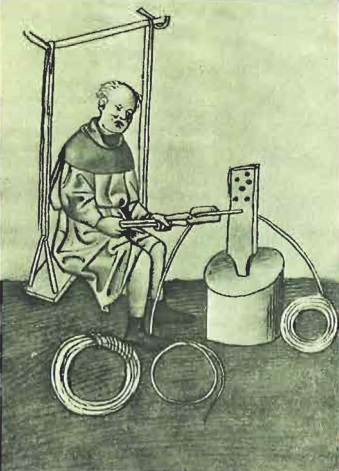
Over time, one particular method of wire-making eclipsed all others. This method, called “drawing”, involves pulling a metal rod through a series of cone-shaped holes of steadily decreasing diameter. These holes are bored through either a “die” or a “drawplate”, the latter being a plank of metal, wood, or bone. When passed through a hole smaller than its diameter, the rod becomes thinner and longer.
The origin of this wire-making technique is a mystery over which historians have debated for centuries. Some say that wire drawing was invented by the Ancient Egyptians. Others suspect that Persians employed it as early as the 6th Century B.C. Others still contend that it was first used by the Romans, while many more argue that Merovingian Franks invented it in the 7th Century A.D. Most historians agree, however, that the first written reference to the drawplate is the Treatise of Theophilus, an early 12th Century Latin text describing various medieval arts, and that the earliest universally-accepted drawplates are 10th Century Viking artifacts.
Although wire drawing gradually superseded all other forms of wire-making techniques during the Middle Ages, it would certainly be possible for medieval and post-medieval jewelers to craft their wires using more ancient methods like block twisting and strip-drawing. Wire makers might even be forced to use these methods if they found themselves in want of a drawplate. Therefore, although the spiral wire on the Lot 21 brooch may be more consistent with pre-medieval jewelry, it by no means eliminates the possibility that the artifact was crafted in more recent times.
Want to Help?
If you enjoyed this article and would like to help support this website, please check out our online bookshop:
.
.
.







Leave a Reply